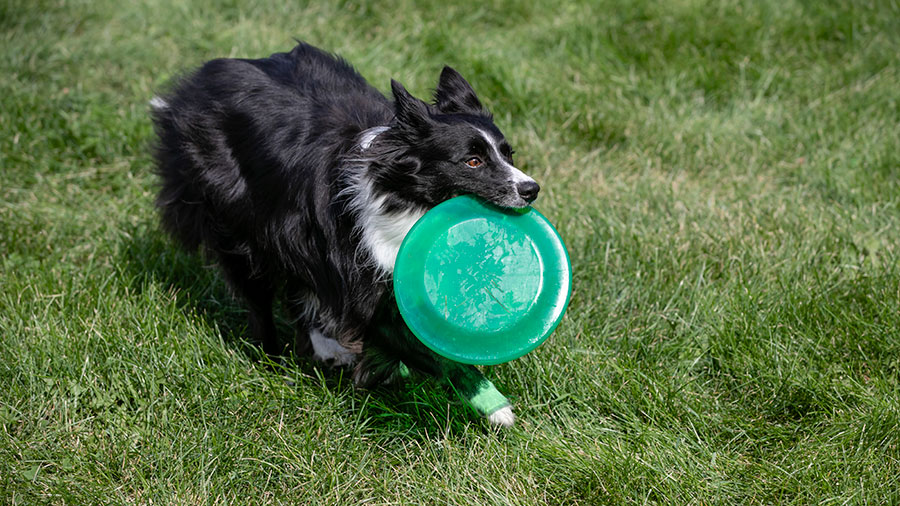Summer weather is here: time to enjoy the outdoors with our pets! Dr. Canaan Shores, a veterinarian with the urgent and convenient care service at the University of Illinois Veterinary Teaching Hospital, offers advice to help keep your fun-filled summer safe.
Never, Ever Leave Pet in Car
Perhaps the most important warning Dr. Shores has for all pet owners is to never leave your pet alone in the car. “On a sunny 70° F day, the temperature in a car can rise to 100° F within 20 minutes and will only continue to rise,” he says.
As you and your pet start to enjoy the warmer weather, it may be a good idea to do it slowly. Dr. Shores says, “Some of those very warm, humid spring days can trigger heat stroke because dogs are not adjusted to it. Gradually expose your pet to heat and humidity in short bursts.”

Heat Stroke 101
Pet owners should learn the signs of heat stroke and how to prevent it.
“The early signs of heat stroke include excessive panting or difficulty breathing, abnormal gum color (pale or purple to blue), excessive salivation, and disorientation,” says Dr. Shores.
As the condition progresses, the signs may change. “The pet may develop bloody vomiting, diarrhea with blood, very small red spots on the skin or gums, bruising, seizures, and/or collapse,” he says.
The temperature of your pet will be very elevated. “Normal temperature in dogs and cats is <102.5° F; heat stroke occurs when the temperature is above 105.8° F.”
Dr. Shores wants pet owners to know pets may have clinical signs of heat stroke at lower body temperatures, so, if signs are noticed, the pet should be transported in a vehicle with air conditioning to the nearest emergency veterinarian.
If there is a delay in reaching the veterinarian, he advises, “Owners should move the pet to a cooler environment and run tepid (not cold) water over the pet and place them in front of a fan. Applying cold water, ice packs, wet towels, or alcohol to pets can be counterproductive and is never recommended.”
As soon as possible, get the pet medical attention.
Dog Breeds and Heat Stroke
Certain physical characteristics may predispose some dogs to overheating. Dr. Shores explains that dogs with brachycephalic syndrome—those with shortened snouts and flat faces such as English and French bulldogs, Boston terriers, Pekingese, and pugs—should be monitored very closely in the heat.
“Other breeds shown to be more susceptible include Labrador retrievers and golden retrievers. Pets with long hair, significant fat covering, or that are well-muscled can also be predisposed to heat stroke,” says Dr. Shores.
Heartworms, Fleas, and Ticks
Another aspect of the warmer weather pet parents should keep in mind is the increase in insects and parasites. For pets in the Midwest, staying on heartworm and flea/tick prevention year-round is extremely important.
“While there are certainly seasons when pets are more likely to be exposed to these parasites, we have diagnosed heartworm disease and flea and tick infestations in every month of the year here in central Illinois,” notes Dr. Shores.
Summer Toxins and Other Dangers
Spending more time outdoors with your pet increases various non-weather-related risks, too.
“Certain toxicities tend to rise with the summer months, including salt toxicity from saltwater when visiting a beach, certain plants, rodenticides, slug and snail baits, and mole and gopher baits,” he says. Herbicides tend to be safe for pets if they are applied per label instructions and the pet stays off the grass until the product has dried.
If you know or suspect that your pet has ingested something toxic, you can call the ASPCA Animal Poison Control Center at 888.426.4435 for emergency advice.
In addition to toxins, outdoor time brings the potential for lacerations, limping/lameness, GI disturbances, and dog interactions (and possible bite wounds) for our pets.
Lastly, Dr. Shores notes that, “For pets that have skin and ear allergies, the warmer months of the year are often the times pets struggle most with scratching, redness, and hair loss.”
Being aware of potential dangers, keeping your pet hydrated, and avoiding the hottest parts of the day and prolonged periods in the sun will help you and your pet have a happy, healthy summer.
By Sarah Brink




